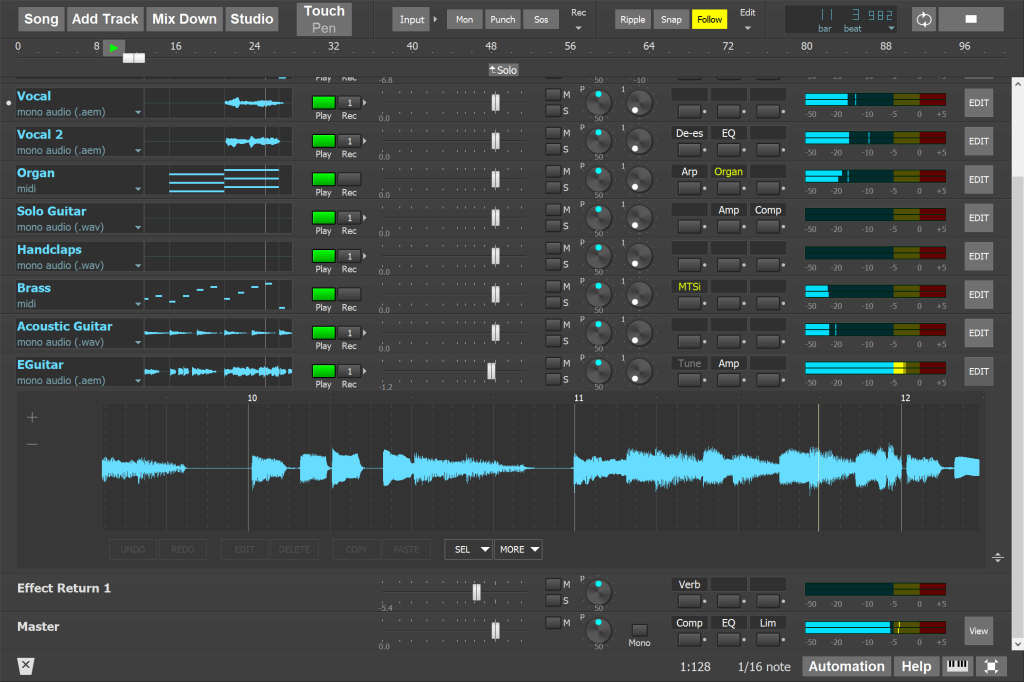Here’s another great underground DAW. The elegant, tape-inspired MultitrackStudio runs on desktop and iPad – and now not only does it to polyphonic expression, but it breaks ground in supporting MIDI 2.0, as well.
MultitrackStudio 10 for desktop and the corresponding MultitrackStudio 4 for iPad arrived this month. It’s not a widely-known tool, to be sure, but there’s some beautiful work done by developer Bremmers Audio Design.
It’s also the first DAW I know of to officially support MIDI 2.0. That updated MIDI is new enough that it’s been largely limited to tech demos – literally, talks by manufacturers and not much else. But MIDI 2.0 is officially approved, and a lot of times what you need to get out of the chicken-and-egg problem in tech and standards is a nice, piping hot chicken cacciatore. Wait, I’m not sure that metaphor made any sense – I might just be hungry. Anyway.

MPE (MIDI Polyphonic Expression) is the part of this update you’ll likely actually use. That is now widely supported by both hardware and software, and allows per-note expression for more than one note at a time – which as I keep saying, is really common sense.
Part of the reason then MultitrackStudio becomes interesting as a model is that it shows how you’d support both. The developers say they’ve used MIDI 2.0 internally throughout the DAW, and then for the end user already support registered per-note controllers and per-note pitchbend. They can translate these to and from MPE, so you can work with existing MPE input devices, instrument plug-ins, and hardware synths.
There’s even similar MPE and MIDI 2.0 support in the iPad version, which is a promising sign of having the ability to work with these anywhere you like without having to worry about having a conventional computer handy.
Giel Bremmers, the developer, explains that internally the software can already use MIDI 2.0’s higher resolution – something we’ve been waiting on in MIDI for a long, long time. That means 32-bit resolution for controllers and 16-bit resolution for note velocities, they tell us. You can’t export that as a saved MIDI file, because the file format doesn’t exist yet as part of the standard, though presumably, that’s coming.
Note that what isn’t here yet is MIDI-CI (Capability Inquiry) and Property Exchange, which Giel tells us they left out since there’s no hardware that uses it yet. (I think again there have been tech demos, but nothing shipping in a way a consumer could use.)
Apple added this stuff under the hood in Core MIDI for macOS 11 and iPadOS 14 – so this is also a sign of just how fast Apple is moving. That opens up some new possibilities. Giel explains:
Right now it would be perfectly possible for others to use virtual MIDI on iPad – for example, a MIDI 2 synth (or keyboard app) would connect to MultitrackStudio via MIDI 2, and it would still work with MIDI 1 apps as iPadOS 14 converts between MIDI 1 and MIDI 2 where appropriate.
This is also a pretty powerful DAW for the price of a mid-range plug-in. For the desktop software, Standard is US$69, Pro $119 – and upgrades are $23 and $39 respectively, or free if you bought after the 28th of October. That supports macOS 11, OS X 10.9, and 64-bit and 32-bit Windows.
I really enjoy that they stuck to a straightforward audio/MIDI interface that just keeps channels and content visible. I can imagine this might be useful even as a companion to your existing workflow, for when you want a more traditional multichannel editor for recording, mixing, or mastering.
This sort of thing used to be commonplace – even something people assumed was essential alongside a DAW. It’s probably on my mind because lately my distraction addiction is a Facebook group on obsolete software, but remember things like Macromedia’s Deck II? I’m fairly certain a lot of people mourned the loss of these kind of tools, and it wasn’t that the use case died so much as the business case for the developer. (Take that last phrase and apply it to a great many things in music tech.)
But this is no nostalgia trip or “DAW for Boomers” – apart from as far as I know being the first shipping DAW to implement MIDI 2.0, check the full specs:
https://www.multitrackstudio.com
So there you have it – March 2021, a landmark in MIDI evolution, very possibly.